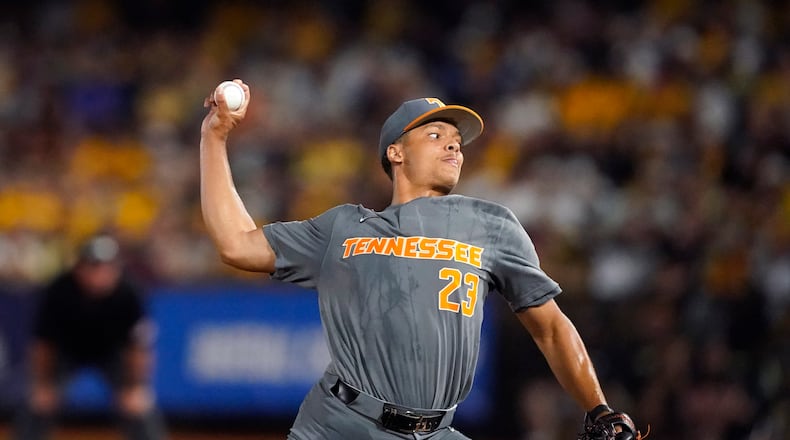Burns, a 6-foot-4, 215-pound right-handed pitcher, did know the Reds had interest in him. He talked to them multiple times and saw a game against the Cleveland Guardians at Great American Ball Park in the spring.
“I was really impressed with the organization,” Burns said. “They just talked about development and pitching, and I had a good time.”
The experts did not expect the Reds to take Burns, however. MLB Pipeline predicted the Reds would draft University of Georgia outfielder/third baseman Charlie Condon, while Kiley McDaniel, of ESPN, thought the Reds would draft University of Florida first baseman Jac Caglianone.
instead for the second straight year, the Reds picked a 21-year-old Wake Forest pitcher in the first round. In 2023, they took Rhett Lowder, another right-hander who’s now with the Double-A Chattanooga Lookouts, with the No. 7 pick.
Burns was born in Naples, Italy, when his parents were in the Navy. He grew up in Gallatin, Tenn., and graduated from Beech High School in Hendersonville, Tenn.
Burns was named the Atlantic Coast Conference Pitcher of the Year and was a first-team All-American in his first season at Wake Forest after two seasons at Tennessee. He was 10-1 with a 2.70 ERA in 16 starts and 100 innings. He set a school record with 191 strikeouts.
Burns and Lowder are both products of the Wake Forest Pitching Lab, which describes itself as the “biomechanics evaluation destination for pitchers at every level of the game.” According to its website, the lab’s “state-of-the-art facility, cutting edge technology and expert staff enable us to perform a comprehensive evaluation and analysis of a pitcher’s mechanics and develop customized training programs aimed at reducing the risk of injury and enhancing performance.”
Burns said, “That pitching lab they have is no joke.” He said he worked with new technology and learned how to move better. It helped him elevate his game.
Burns said he became a better player, a better person and a better overall pitcher in his season at Wake Forest. He made “major improvements” to his secondary pitches.
The Reds see him becoming a top-of-the-rotation starting pitcher quickly, Reds Director of Amateur Scouting Joe Katuska said in a press release.
“It’s a profile that we always start with in the draft, and Chase checks all the boxes,” Katuska said. “We love the quality and depth of his pitch mix, and his competitiveness. He’s made great strides since we first saw him pitch 4 years ago, and see him continuing on that same trajectory.”
The Reds beat the odds to get the No. 2 pick in the second year of the MLB Draft Lottery. They had the 16th-best record (82-80) in baseball last season and were one of 18 teams eligible for the lottery. They had a 0.9% chance of winning the top pick.
The Reds last had a No. 2 pick in 2017 when they drafted Hunter Greene and 2016 when they drafted Nick Senzel.
The Cleveland Guardians, who had the No. 1 pick for the first time in franchise history, selected Oregon State second baseman Travis Bazzana, who became the first second baseman taken first overall.
Bazzana and University of Georgia outfielder/third baseman Charlie Condon were the first and second players in MLB.com’s ranking of the top 100 prospects. The Colorado Rockies took Condon with the No. 3 pick.
Burns was the sixth-ranked prospect but the second-ranked pitcher on the list.
According to the MLB.com scouting report, “Burns operates at 97-99 mph and reaches 102 with his heater, but it’s fairly straight and batters get a good look at it coming out of his high arm slot, so it gets hit harder than it should at times. His tight slider is a true beast that sits in the upper 80s and has generated a 60 percent swing-and-miss rate during the last two seasons. He also owns a plus low-80s curveball.”
Also on Sunday night, with their second-round pick, No. 51 overall, the Reds took Tyson Lewis, a 6-foot-2, 195-pound shortstop from Millard West High School in Omaha, Neb. MLB.com ranked him the 39th-best prospect in the draft.
“Lewis was getting some first-round buzz thanks to him showing more impact with his left-handed swing, solid speed and the ability to stay up the middle on the infield,” Jonathan Mayo wrote on MLB.com.
Lewis hit .496 with eight home runs, 41 RBIs and 31 stolen bases as a senior. He was named the Gatorade Nebraska Baseball Player of the Year. He committed to play at Arkansas. His dad Peyton played at Creighton and was an 18th-round pick of the Toronto Blue Jays in 1999.
In the Competitive Balance Round B, with the 71st overall pick, the Reds drafted LSU’s Luke Holman, a 6-4, 204-pound right-hander.
Holman, 21, was the 45th-ranked prospect on MLB.com’s list. He was 9-4 with a 2.75 ERA and 127 strikeouts in 16 games as a junior.
Holman spent one season at LSU after two seasons at Alabama. He’s a graduate of Wilson High School in West Lawn, Pa., and was drafted in the 20th round by the Blue Jays in 2021 but chose not to sign.
Holman is also the son of a former minor leaguer. His dad Craig played at Jacksonville State and spent eight seasons (1991-98) in the Phillies organization.
The draft continued Monday with eight more rounds. The Reds had picks in each round. They also have one pick in each of the final 10 rounds, which will take place Tuesday.
About the Author

